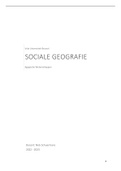Class notes
CNSD Aantekeningen Hoorcolleges Thema 1-3
- Course
- Institution
Dit document bevat aantekeningen van alle hoorcolleges van thema 1-3: 'addiction', 'neuro-oncology' en 'stress'. Met deze aantekeningen heb ik een 8,9 gehaald voor mijn tentamen,
[Show more]












